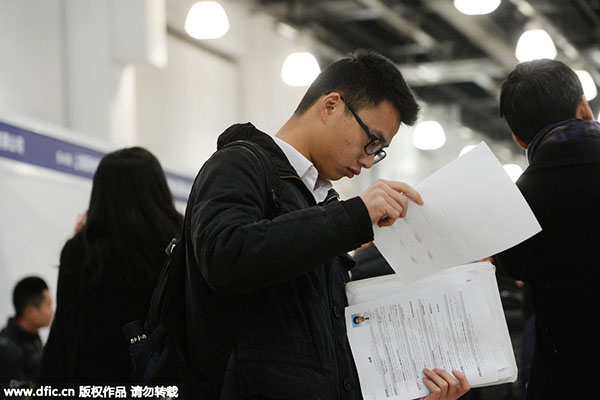 |
|
A man prepares his resume at a job fair for college graduates in Shanghai, Jan 9, 2015.Finding a satisfying white-collar job is getting more and more challenging this winter. The latest report showed that competition for white-collar jobs has become fiercer in the fourth quarter, with nearly 37 job seekers contending for the same position on average. [Photo/IC] |
Finding a satisfying white-collar job is getting more and more challenging this winter. The latest report showed that competition for white-collar jobs has become fiercer in the fourth quarter, with nearly 37 job seekers contending for the same position on average.
This is a jump from 26, 29 and 35 in the first three quarters in 2015. And competition among job hunters in second-tier cities is even fiercer than in first-tier cities.
Zhaopin, a Chinese human resources website, released the quarterly report for white-collar workers on Tuesday. It contributed to the grim overall outlook for the job market and the economic situation in general.
"Firstly, demand for talent was shrinking with the slowdown of China's economic growth. Many industries began to lay off employees who were forced to go back on the job market," said the report. "Besides, the Internet industry, which used to be a big source of positions, is also cutting its demand for talents due to some setbacks which happened in the second half of 2015."
"At the same time, more employees were considering changing jobs, leading to more competition among job hunters."
Continuing the trend of the previous quarters, competition in the job market in second-tier cities, especially those in Northeast China, is even fiercer than in first-tier cites.
In Zhaopin's competition index for major cities, Chengdu of Sichuan province ranked first. Shenyang, Dalian, Changchun and Harbin, all from Northeast Chinese provinces, ranked second, sixth, eighteen and tenth.
Once China's industrial base, the northeast provinces in China experienced an even faster economic slowdown than the rest of the country. Liaoning's GDP expanded only 2.6 percent during the first half of the year as the nation is striving to achieve the around 7-percent growth target this year.
"The northeast Chinese provinces are facing more difficulties during the structural reform. Many industries could not create jobs," said the report.
"At the same time, more second-tier cities including Chengdu, Tianjin and Suzhou are becoming more attractive as living and working environments. However, compared with the first-tier cities, job opportunities are not as sufficient as they thought. So competition in second-tier cities is even fiercer than first-tier cities."
